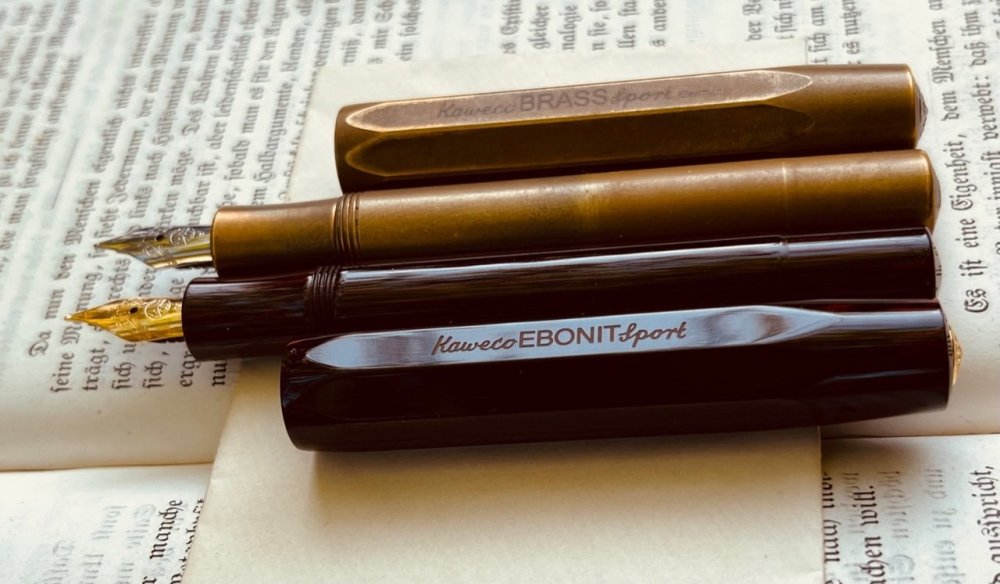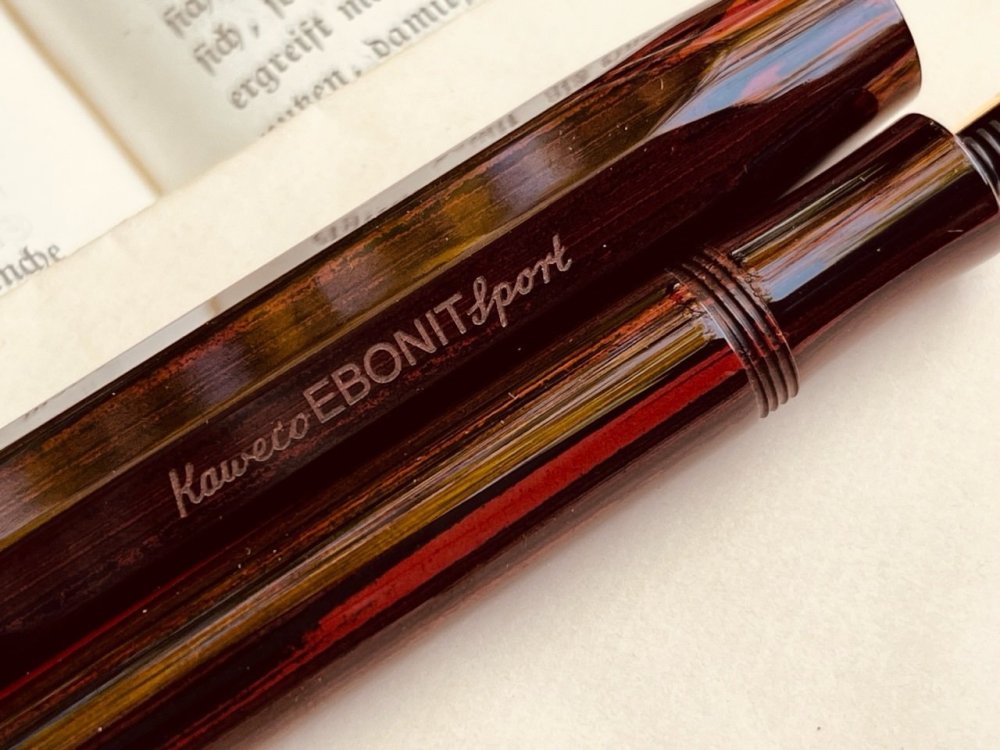Search the Community
Showing results for tags 'kaweco'.
-
Hi. Would you help me identify my pen's model? It's a big, celluloid button filler. The clip is marked "Kaweco" but the nib probably isn't original (Stamped "Warranted 14k, USA" - not too Germanic). No imprints or markings on the body. The pen's shape and overall looks is unlike any Kaweco models...
-
Ever since I was (very kindly) given a Kaweco Sport I've had nothing but problems: the pen regurgitates big blobs of inks out of the blue, the gold plating was gone after the first swiping with tissue paper, but mostly the converters have been terrible: tried Kaweco's original, sad squeeze type, Mon...
-
I have recently posted a review of the Kaweco AC Sport Red LE pen in the pen reviews forum. Here. I am adding a separate review of the Kaweco Ruby Red ink that I used in that pen when I tested it. I used a cartridge, and the Kaweco AC Sport Red LE pen has a F black, steel nib. I also used a 1.1mm s...
- 7 replies
-
- kaweco
- kaweco ink
- (and 4 more)
-
Hey folks! I recently picked up a Kaweco Student. I love the pen very much, and it could easily be a workhorse EDC for me if I could get a bit more ink into it. Which leads us to my question: has anybody out there ACTUALLY converted their Student to an eyedropper fill, and if so what was the exper...
-
Pen Pit Stop : Kaweco Special Red Welcome to the Pen Pit Stop. Here you will find reviews of pens that already have some mileage on them. More specifically, these reviews are of pens that are in my personal collection, and that have been in use for at least a year. I thought it would be...
- 6 replies
-
- pen pit stop
- kaweco
-
(and 1 more)
Tagged with:
-
Hi everyone, recently I bought a pen lot and inside there was this pen. On the barrel there is Helios and a number 21. I can't find any information regarding this so it would be nice if someone can broaden my horizon of knowledge and also tell me what should I do to take care of it, in case it...
-
Kaweco Paradise Blue (cartridge) This a happy turquoise/light teal. It doesn’t like copy paper, it's difficult to scan, dry times are on the longer side and the ink is water resistant. I enjoyed it most with F European nibs upwards. I tried to emulate an UEF nib by reverse wri...
-
I have a Kaweco Elite with tool holes for a wrench for nib removal. I haven't had occasion to need this type of tool yet so I don't have any to try. Is anyone familiar with which wrench may fit. I know there are a few available out there for other pens
-
Hi FPN, A little while ago, I managed a great deal on a vintage Kaweco V12 and 619 set from around 1965. It was a bit of a risk, bought it on eBay with only one picture so didn't really know what condition it was in. Fortunately, it arrived and when I started to clean it and take it apart it turne...
-
I thought Kaweco is one of the oldest pen brands from Germany and it needs the thread where people can show of their Kaweco instruments. So hereby I request all to show us their Kawecos. Would love to know a lot about vintage ones too.
- 321 replies
-
- kaweco
- pen for the day
-
(and 2 more)
Tagged with:
-
Quick comparison of two similar inks I happened to have. Both write and behave really well, although similarly not great on cheap paper. The swabs are pretty shabby because I only have Summer Purple in cartridge form, so I couldn't get much ink on the cotton swab. I made the Poussiere de Lune swab t...
- 17 replies
-
First of all: My passion for fountain pens has been with me for more than 25 years now and has therefore changed many times: from classics from Germany to the pretty colorful divas from Italy to the noble Japanese fountain pens and back again and back again. In the meantime, a small core...
-
liliput Hacking Kaweco Liliput pens for the perfect drawing tool
Juz posted a topic in Fountain & Dip Pens - First Stop
Back in the 1990s I used Waterman pens with #2 nibs for drawing, which seemed to be the most perfect tool — but they frequently leaked and had problems. I didn't get back into fountain pens until recently when I started to hunt for flexible nibs again on a modern, more reliable pen. First I discover... -
When you think about pocket pens chances are the first name that comes to your mind will be Kaweco Sport. The size ant the shape of this pens is almost iconic and the Sport series is rather popular in the community. I think that it's second most popular fountain pen on polish fountain pen boards (th...
-
Which converter fits the Kaweco Dia2 pen (with the standard Bock 060 nib unit)? Kaweco have 3 types on their site - mini for the Sport, squeeze and standard. I bought a standard Kaweco converter but it doesn't remotely fit the pen - it won't even fit in the metal base of the section. Other convert...
-
Some people can wield a big, fat stub and get amazing results. Not me. I'm a sloppy writer and still learning basic penmanship. I rotate my pens and stubs don't like that. I write fast, and stubs don't always forgive me for it. Just for fun, I made a quick comparison of the stubs that I have in my c...
-
Hi everyone, It's great to be part of this fountain pen community. I rediscovered my love and passion for fountain pens recently. Coincidentally, I got my first pocket pen (Kaweco Sport, Bordeaux, medium nib) with Kaweco Caramel Brown ink cartridges and a mini piston convert...
- 18 replies
-
- kaweco
- kawecosport
-
(and 1 more)
Tagged with:
-
I have been collecting writing instruments for a few decades and currently have about 300 of them in my collection. They are mostly vintage, and a few new ones. I try to follow technical evolution as themes of my collection such as filling mechanisms, nib characteristics, materials, etc. I...
- 22 replies
-
- pocket pens
- kaweco
-
(and 2 more)
Tagged with:
-
Here I present to you all a vintage mid 1950's MAHAG piston filler by Kaweco FOA , thanks to all the vintage Volkswagen fan over at multiple automotive online groups and forums who answer my questions and give info For a bit of History , MAHAG is a m...
-
As mentioned in another thread -- -- the parcel my brother'd sent me from the States arrived after a little more than a month in transit yesterday. At around 11:20. I put away the notebooks and checked out the two gel pens and gel-pen refills and finally came to the Kaweco M nib....
-
As a pen (and ink) afficinado that lives in Austria, it amazes me, that so many inks are made locally here, even though there is basically no high quality fountain pen and ink production by Austrian brands. There are cheap (and somewhat ugly in my opinion) "Jolly" branded school pens, and the quite...
-
This is a review for Kaweco Caramel Brown ink. This is the latest shade of brown from Kaweco. The previous brown was called Earth Brown and it's darker. You might still find some older bottles of Kaweco Earth Brown ink and the older ink boxes are a darker brown colour. You can tell if you have one o...
- 2 replies
-
- kaweco
- kaweco ink
-
(and 2 more)
Tagged with:
-
Looking for Kaweco AL sport Fountain Pen in Matte Blue
saadmn posted a topic in Other Brands - Europe
Hi, Is anyone able to get the pen mentioned in the title? If so, I would greatly appreciate it and I will pay for the cost and shipping, and any extra cost towards the effort made to find it. I live in New York. Regards. Note 1: Kaweco now makes this AL sport foun... -
Hi, I am a new member of the forum, I joined because I thought I could find some help regarding my post below. The link should take you to my original post. Basically, I have been looking for a specific Kaweco AL Sport that is no longer produced, with no success. I am hoping there is still a possibi...
-
I was wondering if I could see your kaweco double broad nibs? I’m a little worried that I got a fake one 😕 my double broad has deeper etching and slightly wider design than that of my EF (which came from germany). Also, the etching it slight bronzed. Doesnt show in picture but noticeable when obser...













































































